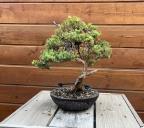Moss like a boss...
- Felidae
-
 Offline
Topic Author
Offline
Topic Author
- Platinum Member
-

- Posts: 687
- Thanks received: 236
I know nothing about the trees, but maybe I can help for someone with a Moss guide. Small exchange for the tree knowledge what I can get from here.
As a rule of thumb for the instant use:
If you collect a species from stone, it’ll like to stay in hard surface with good drainage, no need for organic substrate.
If you collect from bark, good drainage, but it’ll supporting 30-50% organic soil without training.
If you collect from the forest floor, they adapting pretty quickly in any conditions, but grows better with a little organic something mixed in the substrate.
All three can trained less or more for different conditions.
Try to collect different species to understand them. I won’t go to the taxonomy, but most short haired types likes less humidity with more air movement, longer types usually prefers higher humidity.
Timing:
The best local collection time is depends where you want to use it. For outdoor use, doesn’t really matter. For indoor use, the best moment for collecting is when the temperature isn’t much lower outside. Do early morning or late evening if you collecting in hot, dry season.
Method:
Try to find bigger moss patches and take small portions from the side, where the moss can grow back easily. If you collect with barks, never do from the trees. You’ll always find fallen bark in the forest floor with nice moss on it.
Take with yourself a pocket knife (not your best Swiss one!), spatula/scraper, plastic box(es), small plastic bags for the different species and a marker to note into the bags (I usually note the location and the species if I know)
The moss you collected, put flat in the plastic bag, close wisely (I prefer zip bags) and layering them into the box. You can keep them like this for several weeks in dark place if needed.
Cleaning:
Try to avoid cold tap water. If you use tap water, let it air for few days. Best is rainwater, like for most of the plants. Immerse the patches under water and let them soak for5-10 minutes. Pick up carefully any dead material, pine needles and most of the bugs and seeds what you can find.
Training, storing, cultivating:
Take a (or some) transparent plastic box with lid.
Put a layer of crushed carbon in the bottom and the top of it a layer of orchid bark (or similar stuff) mixed 50% with the substrate in what you want to use the moss. In there you can lay the patches next to each other. Water it generously, but watch out! They really hate to stay in water for longer periods. The water level need to stay in the carbon layer. Don’t need regular watering, but they like misting. Control the water level in the carbon. If it’s too low, fill it up. I like to use springtails and dwarf isopods to keep the culture completely clean.
Outdoors
Make some ventilation holes in the higher side section of the box, but not onto the lid.
Don’t put them in full sun, keep on the shade (longer hair types)or half shade (shorter hair types). You can expect some bugs crawling in.. No biggie..
Indoors
No need holes for the box. If you keep in dark, the moss will growing long hair and it’ll less hardy when it’s time to use. If you put near a window,or use artificial light in the adequate spectrum, it’ll appreciate.
For indoor and outdoor use, you can start using your culture in no time, when it’s established and started to reproduce. If you want to use them, put the chosen patches in a similar, but open box, or let open your original box few days before.
Collection site example:
This image is hidden for guests.
Culture box example:
This image is hidden for guests.
In terrarium:
s6.postimg.cc/uy525o429/BD9_A35_CE-4831-...642_F0_C6_F70_ED.jpg
This image is hidden for guests.
As a rule of thumb for the instant use:
If you collect a species from stone, it’ll like to stay in hard surface with good drainage, no need for organic substrate.
If you collect from bark, good drainage, but it’ll supporting 30-50% organic soil without training.
If you collect from the forest floor, they adapting pretty quickly in any conditions, but grows better with a little organic something mixed in the substrate.
All three can trained less or more for different conditions.
Try to collect different species to understand them. I won’t go to the taxonomy, but most short haired types likes less humidity with more air movement, longer types usually prefers higher humidity.
Timing:
The best local collection time is depends where you want to use it. For outdoor use, doesn’t really matter. For indoor use, the best moment for collecting is when the temperature isn’t much lower outside. Do early morning or late evening if you collecting in hot, dry season.
Method:
Try to find bigger moss patches and take small portions from the side, where the moss can grow back easily. If you collect with barks, never do from the trees. You’ll always find fallen bark in the forest floor with nice moss on it.
Take with yourself a pocket knife (not your best Swiss one!), spatula/scraper, plastic box(es), small plastic bags for the different species and a marker to note into the bags (I usually note the location and the species if I know)
The moss you collected, put flat in the plastic bag, close wisely (I prefer zip bags) and layering them into the box. You can keep them like this for several weeks in dark place if needed.
Cleaning:
Try to avoid cold tap water. If you use tap water, let it air for few days. Best is rainwater, like for most of the plants. Immerse the patches under water and let them soak for5-10 minutes. Pick up carefully any dead material, pine needles and most of the bugs and seeds what you can find.
Training, storing, cultivating:
Take a (or some) transparent plastic box with lid.
Put a layer of crushed carbon in the bottom and the top of it a layer of orchid bark (or similar stuff) mixed 50% with the substrate in what you want to use the moss. In there you can lay the patches next to each other. Water it generously, but watch out! They really hate to stay in water for longer periods. The water level need to stay in the carbon layer. Don’t need regular watering, but they like misting. Control the water level in the carbon. If it’s too low, fill it up. I like to use springtails and dwarf isopods to keep the culture completely clean.
Outdoors
Make some ventilation holes in the higher side section of the box, but not onto the lid.
Don’t put them in full sun, keep on the shade (longer hair types)or half shade (shorter hair types). You can expect some bugs crawling in.. No biggie..
Indoors
No need holes for the box. If you keep in dark, the moss will growing long hair and it’ll less hardy when it’s time to use. If you put near a window,or use artificial light in the adequate spectrum, it’ll appreciate.
For indoor and outdoor use, you can start using your culture in no time, when it’s established and started to reproduce. If you want to use them, put the chosen patches in a similar, but open box, or let open your original box few days before.
Collection site example:
This image is hidden for guests.
Please log in or register to see it.
Culture box example:
This image is hidden for guests.
Please log in or register to see it.
In terrarium:
s6.postimg.cc/uy525o429/BD9_A35_CE-4831-...642_F0_C6_F70_ED.jpg
This image is hidden for guests.
Please log in or register to see it.
by Felidae
The following user(s) said Thank You: Auk, Ricky73, Madartej21, spacewood, Clicio, Andrew1185uk, crent89, jin21, BlackValorInc, DogDoc and 2 other people also said thanks.
Please Log in or Create an account to join the conversation.
- crent89
-
 Offline
Offline
- Platinum Member
-

- Posts: 482
- Thanks received: 230
where im from spring has hit pretty hard and we have been getting some good heat. Any moss i would have been able to collect in winter is now all dried up (yellow). after searching local parks and nature trails i cant find anything green. so my question is.
would i be able to collect dried up moss grind it down to small pieces and sprinkle it into a container like mentioned above and get moss to grow? or would the moss have to be alive and green?
would i be able to collect dried up moss grind it down to small pieces and sprinkle it into a container like mentioned above and get moss to grow? or would the moss have to be alive and green?
by crent89
Please Log in or Create an account to join the conversation.
- Felidae
-
 Offline
Topic Author
Offline
Topic Author
- Platinum Member
-

- Posts: 687
- Thanks received: 236
Yes, the spores are all good. Mix with a little beer or yoghurt in a blender (even plain water is ok if you use them in the box). With that method, you can make mossy pots or stones much easier also.
/I forgot to mention in the post that I have a screen installed over the carbon layer/
/I forgot to mention in the post that I have a screen installed over the carbon layer/
Last Edit:7 years 6 months ago
by Felidae
Last edit: 7 years 6 months ago by Felidae.
The following user(s) said Thank You: crent89
Please Log in or Create an account to join the conversation.
- crent89
-
 Offline
Offline
- Platinum Member
-

- Posts: 482
- Thanks received: 230
Felidae wrote: Yes, the spores are all good. Mix with a little beer /
:huh: beer! i would rather drink it. lol thanks for the advice going to try it today keeping fingers crossed.
If i try to grow it in a shallow pot would it be smart to make a small tent for it to keep it humid? or with it just being open work.
by crent89
Please Log in or Create an account to join the conversation.
- Felidae
-
 Offline
Topic Author
Offline
Topic Author
- Platinum Member
-

- Posts: 687
- Thanks received: 236
crent89 wrote: :huh: beer! i would rather drink it. lol thanks for the advice going to try it today keeping fingers crossed.
If i try to grow it in a shallow pot would it be smart to make a small tent for it to keep it humid? or with it just being open work.
I already saw your pain in my hubby’s eyes..
You’ll get much better results with a small tent. I have a friend who use wooden stick frame and cling film on wabis. Cheap, lightweight and you chose the size and shape.
by Felidae
The following user(s) said Thank You: Clicio, crent89
Please Log in or Create an account to join the conversation.
- Clicio
-
 Offline
Offline
- Platinum Member
-

- Posts: 3555
- Thanks received: 1549
After all that very interesting and useful info Felidae offered, I would like to contribute with a video on the subject, very well done.
Sorry to bring this thread up again, but it's worth it I guess:
Sorry to bring this thread up again, but it's worth it I guess:
by Clicio
The following user(s) said Thank You: petermcdonald
Please Log in or Create an account to join the conversation.
